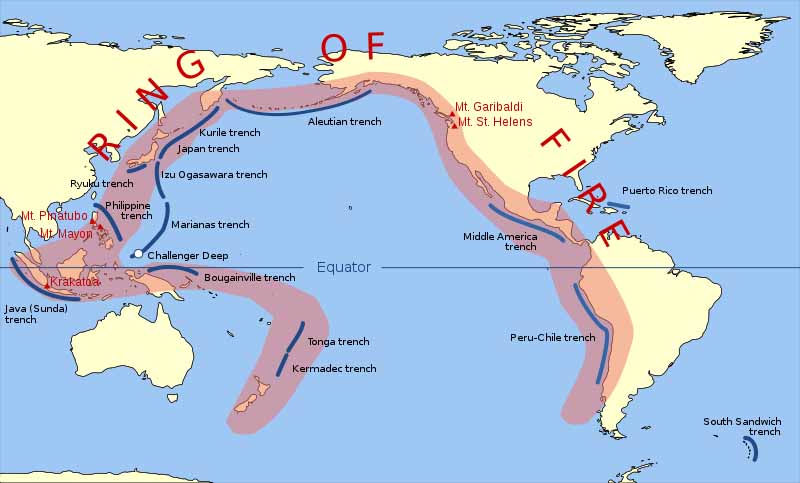

The tectonic plates continue to break up in the notorious Pacific Ring of Fire with an increase in magnitude. Currently we find a 6.9 earthquake off the coast of northern California. Over in the Puerto Rico trench we also find an increase in seismic activity causing earthquakes in Cuba.
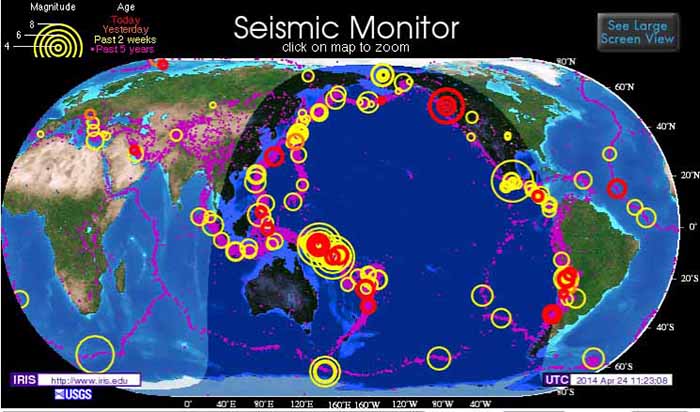
Ring of Fire Earthquakes March-April 2014
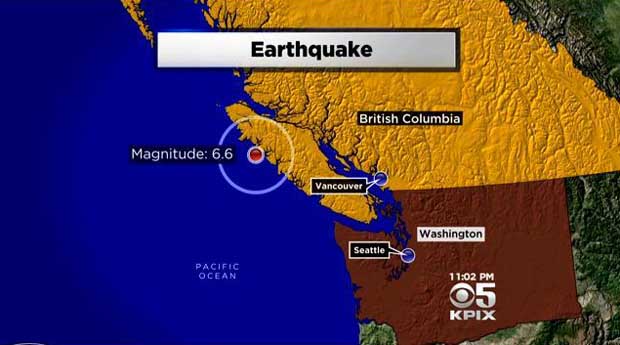
April 23, 2014
Glass rattled, buildings swayed, but no damage was reported after a magnitude 6.6 earthquake hit off the northern coast of Vancouver Island on Wednesday night. Two aftershocks were reported in the hour following the quake. The first was magnitude 5.0 at 8:20 p.m. and the second magnitude 4.2 at 8:41 p.m. A third aftershock, at 4.2, was recorded at 10:16 p.m. - CBS News
Spike in Earthquakes? An 'Illusion' Raises New Questions NBC - April 21, 2014
Some of the best minds in earthquake science have been counting quakes and analyzing seismic waves to see if the largest in a string of recent quakes - the magnitude-8.2 tremor in Chile on April 1 - might have triggered others far, far away. Experts for years have known that the seismic waves from one quake can trigger a quake somewhere else - a process known as "dynamic triggering."
7.5-magnitude quake strikes off Papua New Guinea CNN - April 19, 2014
An earthquake struck late Saturday off Papua New Guinea's eastern coast with a preliminary magnitude of 7.5, the U.S. Geological Survey said. The quake struck at 11:27 p.m. (9:27 a.m. ET) and occurred at a depth of 19 miles (32 km), the USGS said. It was centered 47 miles (75 km) southwest of Panguna, Papua New Guinea. After the quake, the Pacific Tsunami Warning Center issued a tsunami warning for Papua New Guinea and the Solomon Islands, but then canceled it.
After an earthquake hit the Solomon Islands at 6:28 a.m. Saturday, April 19, the National Weather Service issued a statement that the earthquake poses no tsunami danger to Oregon, Washington, British Columbia, Alaska or California. The earthquake's magnitude was recorded at 7.8, with depth of 6 miles. According to the National Tsunami Warning Center, had the earthquake triggered a tsunami, it would take about 14 hours to reach the Pacific Northwest coast. The region has suffered from a slew of major earthquakes this month, and the Solomon Islands were hit with devastating flash floods earlier in April.
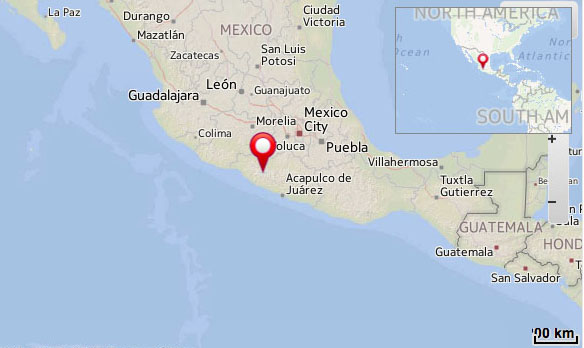
 7.5 magnitude earthquake strikes in southern Mexico CNN - April 18, 2014
7.5 magnitude earthquake strikes in southern Mexico CNN - April 18, 2014
A powerful earthquake shook central and southern Mexico on Friday. The US Geological Survey calculated its magnitude at 7.5 and said it was centered near the Pacific resort of Acapulco, where many Mexicans are vacationing for the Easter holiday. An Associated Press reporter said it was felt strongly in the resort city but there were no immediate reports of injuries or damage. The quake shook Mexico City for at least 30 seconds, with buildings swaying as people fled high rises and took to the streets. Because of the Easter holiday, that city was less crowded than usual. Mexico City is vulnerable even to distant earthquakes because much of it sits atop the muddy sediments of drained lake beds that quiver as quake waves hit.
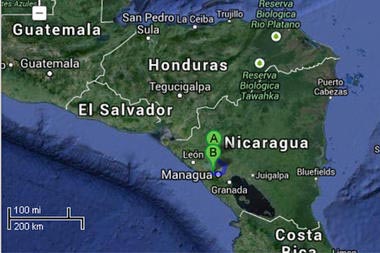
New Quake Shakes Nicaragua; Nation on Alert Live Science - April 11, 2014
Another powerful earthquake hit Nicaragua today (April 11), less than a day after an earthquake caused widespread damage and injuries in the capital of Managua and surrounding towns. The magnitude-6.6 temblor struck today at 2:29 p.m. local time according to the U.S. Geological Survey (USGS). Yesterday, a magnitude-6.1 earthquake hit at 5:27 p.m. local time. The magnitude-6.6 quake's epicenter was about 15 miles (24 kilometers) south of Granada. The earthquake originated 86 miles (139 km) deep, much deeper than yesterday's damaging temblor, the USGS reports. The quake was felt widely, including in El Salvador and Costa Rica. More than 250 people were injured during Thursday's earthquake and one woman died of a heart attack, according to SINAPRED, the national disaster management agency.
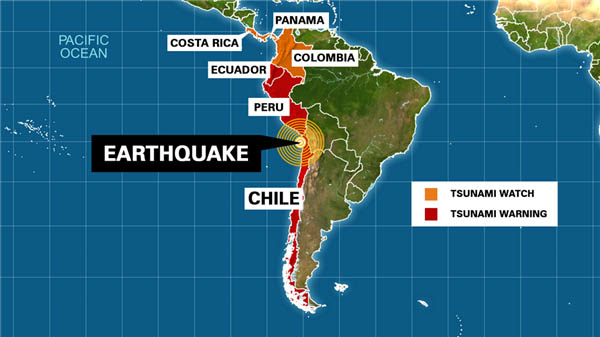
April 2, 2014 Iquique 8.2 earthquake Wikipedia
 Chile leader evacuates as 7.6 second big quake strikes BBC - April 3, 2014
Chile leader evacuates as 7.6 second big quake strikes BBC - April 3, 2014
 Chile quake: This was big but a bigger one awaits, scientist says CNN - April 2, 2014
Chile quake: This was big but a bigger one awaits, scientist says CNN - April 2, 2014
Chile's Recent Earthquake Defied Expectations Scientific American - April 23, 2014
Monika Sobiesiak wasnÕt expecting the morning of April 2 to start with such an adrenaline jolt. But as she scrolled through a list of earthquakes on her mobile phone, she saw that overnight a series of quakes had rocked the coast of northern Chile - almost exactly where she had installed a seismometer network a few years earlier.
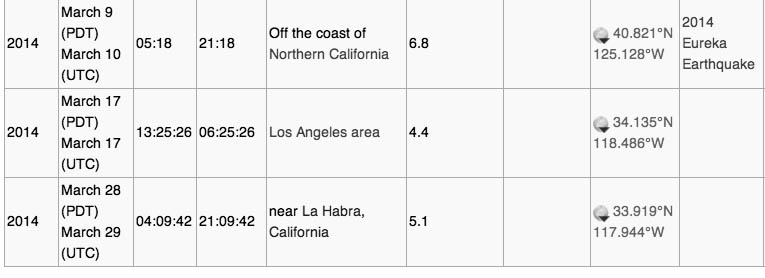
 5.1 Earthquake felt in Los Angeles area of California BBC - March 17, 2014
5.1 Earthquake felt in Los Angeles area of California BBC - March 17, 2014
The quake happened at about 21:10 local time on Friday (04:10 GMT on Saturday) and its epicentre was 1 mile (2km) east of the town of La Habra.
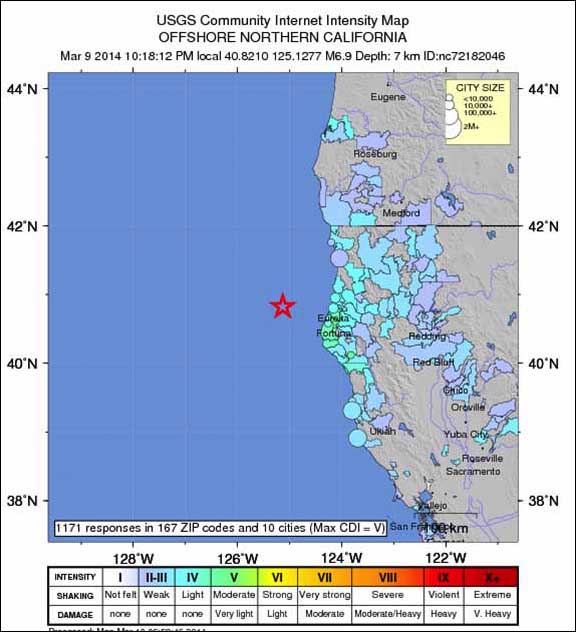
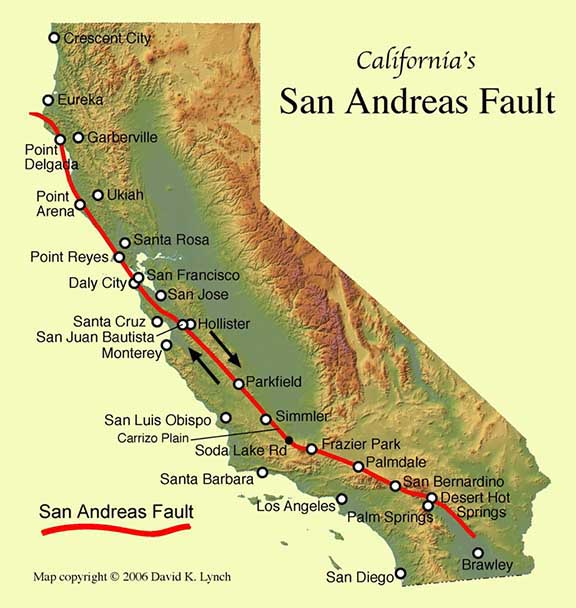
Magnitude 6.9 earthquake hits 50 miles west of Eureka NBC - March 10, 2014
A magnitude-6.9 earthquake struck off the coast of Northern California on Sunday night, the U.S. Geological Service reported. The epicenter was 48 miles west-northwest of Ferndale and 50 miles west of Eureka at a depth of 4.3 miles, the USGS said.
Strong Earthquake Shakes Northern California Live Science - March 10, 2014
An earthquake of preliminary magnitude 6.9 struck last night off the coast of northern California, according to the U.S. Geological Survey (USGS). Shaking was felt across the region as far south as the San Francisco Bay Area and as far north as Eugene, Oregon. There were no immediate reports of damage and no tsunami warnings were issued.
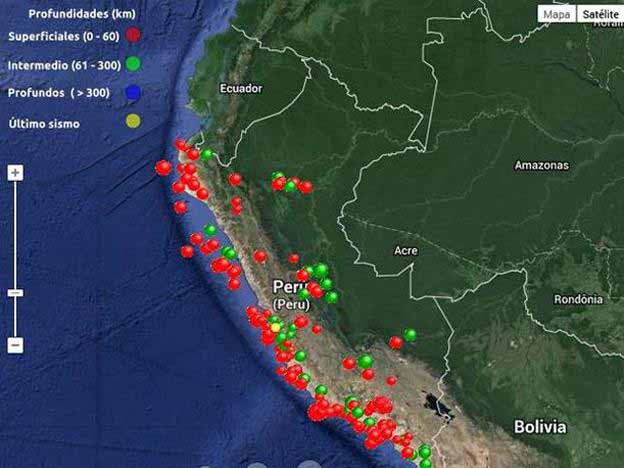
Magnitude 6.3 earthquake strikes northwestern Peru Reuters - March 25, 2014
A magnitude 6.3 earthquake struck northwestern Peru near its border with Ecuador on Saturday, the U.S. Geological Survey reported. Peru's National Civil Defense Institute (INDECI) said it had not received reports of serious damage or injuries, and authorities did not issue a tsunami alert. The quake struck at 6:51 p.m. local time (2351 GMT). Its epicenter was 28 miles south-southwest of Piura and it occurred at a depth of 6.1 miles, the USGS said. Brazilian construction company Odebrecht SA said its $700 million irrigation project in the area was unaffected. Still, the quake jolted the northern coastal region of Peru, with local media reporting that some people ran into the street after the tremor, fearing their homes could cave in. A witness on local radio RPP said the cross on the dome of a local church fell off. The quake was also felt in parts of neighboring Ecuador, according to Peruvian newspaper El Comercio.
Geologist warns that Peru's next earthquake could be a big one Peru This Week - March 25, 2014
Geologist Patricio Valderrama warns that Peru's latest tremors are a sign that the next earthquake will be a big one. There have been more than 50 tremors in Peru over the past few days, something which Peruvian geologist and volcanologist, Valderrama suggests could mean that a big earthquake is on its way. Valderrama says that there has been a long seismic silence in Tumbes, Piura, Lambayeque, Lima, and Tacna, with only small tremors taking place for a while.
"The small tremors don't release the energy of a bigger one. To release the same amount of energy required for one (an earthquake) of 8 (on the Richter scale), there would need to be30 (earthquakes) of 7," he said to '90 segundos matinal' of Frecuencia Latina. This means that the small quakes are a warning that later there will be a large scale earthquake in Peru that will affect all parts of the country, according to Peru.Com. "Our preparation must be constant," Valderrama added. A major concern is that some buildings, particularly in slum areas, will not be able to withstand a heavy earthquake. Valderrama said that with an earthquake registering 8 or more on the Richter scale, 70% of homes would collapse, potentially causing the deaths of thousands. While not wanting to be alarmist, Peru this Week would like to advise our readers in Peru to be prepared for an earthquake, with an emergency kit and escape route organized.
Puerto Rico Trench Wikipedia
Earthquakes and Cuba Local 10 News - March 10, 2014
Over the weekend, another earthquake hit near Corralillo, Cuba, approximately 110 miles east of Havana. This was the fourth earthquake since a magnitude 5.0 impacted the same area in January. The recent tremor was a magnitude 4.7, not exactly a major quake but enough to stir the curiosity. The truth is that Cuba is a seismically active area with a history of major earthquakes, some in excess of 7.0. However, most of Cuba's quakes are expected to occur along the southeastern coast.
In 1766, a major quake with a magnitude of 7.6 rocked the area near Santiago de Cuba. The recent quakes east of Havana are rare and have been felt all the way up into the Keys and parts of Broward County.To understand why this is happening, we have to zoom out and focus on the big picture. Hundreds of millions of years ago, the world's continents were one giant landmass known as Pangaea. Over time, a giant rift occurred tearing these continents apart. Have you ever noticed how the coastlines of the America's line up with the coastlines of Europe and Africa? This separation of landmasses continues today through the process of plate tectonics.
Our continents are sitting on plates that are constantly shifting and moving. For example, there is the North American plate, the African plate and so on. The most recent quakes in Cuba have occurred in a place where the North American plate borders the Caribbean plate. These two plates have been pressing against each other, creating the Cuban Fold and Thrust Belt. This type of fault is very rare but obviously capable of releasing energy. The Caribbean is a hotbed for seismic activity. In 2010, the catastrophic magnitude 7.0 quake that slammed Haiti killed more than 160,000 people. In 1995, the volcano on the island of Montserrat forced the permanent exodus from the capital, Plymouth. While northern Cuba is on the extreme northern fringe of the Caribbean seismic map, it serves as a reminder that this old planet of ours is constantly moving and changing. You and I are just going along for the ride.